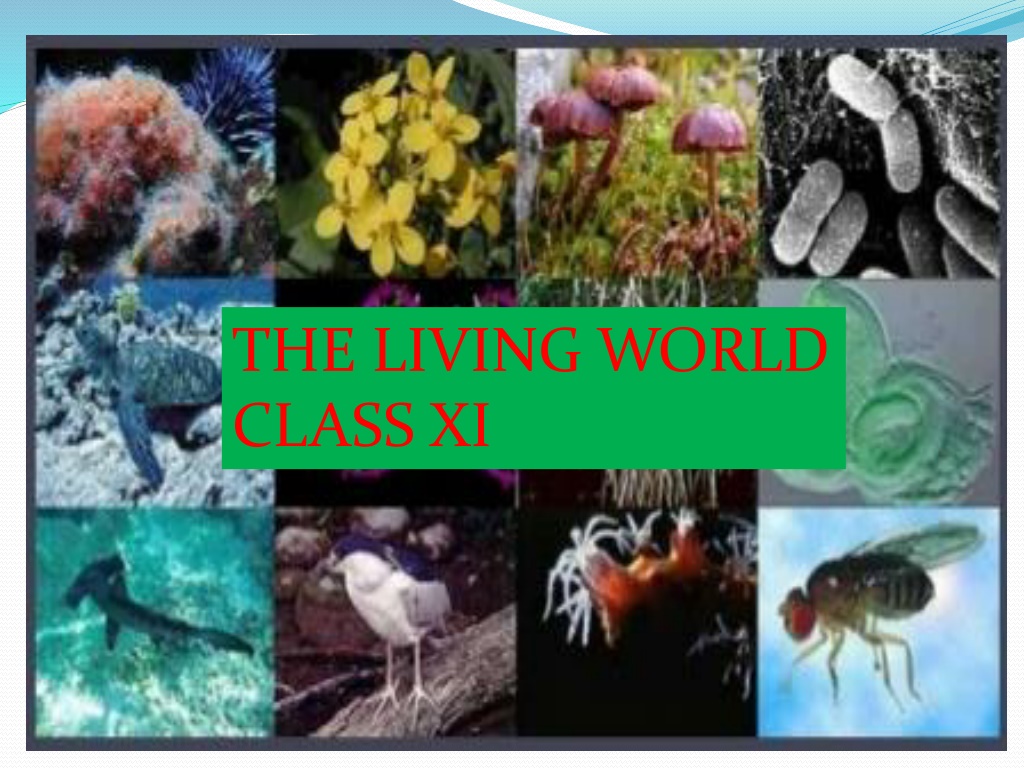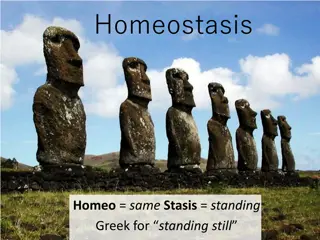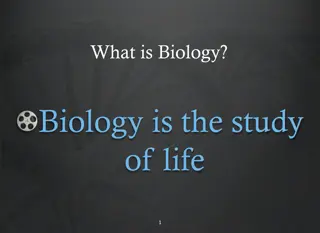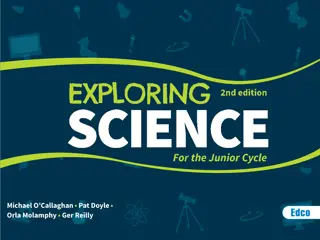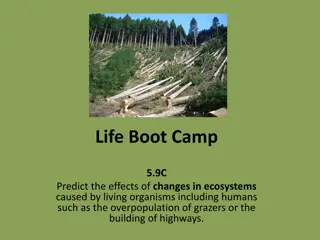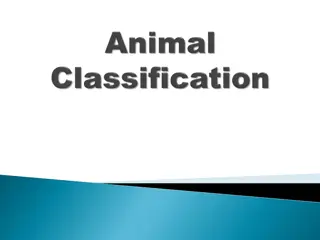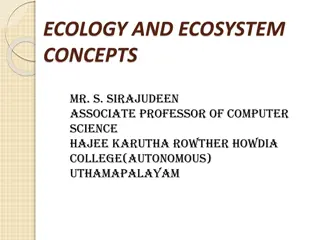Understanding the Characteristics of Living Organisms
Life is a unique biochemical process expressed through chemical reactions leading to growth, development, responsiveness, adaptation, and reproduction. Living organisms exhibit characteristics such as growth, definite shape and size, reproduction, metabolism, and cellular organization. These traits set them apart from non-living entities. The ability for consciousness allows organisms to interact with their environment.
Download Presentation

Please find below an Image/Link to download the presentation.
The content on the website is provided AS IS for your information and personal use only. It may not be sold, licensed, or shared on other websites without obtaining consent from the author. Download presentation by click this link. If you encounter any issues during the download, it is possible that the publisher has removed the file from their server.
E N D
Presentation Transcript
THE LIVING WORLD CLASS XI
THE LIVING WORLD Life is a unique, complex organization of molecules, expressing through chemical reactions which lead to growth, development, responsiveness, adaptation & reproduction. Life is a biochemical process.
Characteristics of living organisms Growth It is the increase in mass and number of cells. In plants, growth by cell division occurs continuously throughout their life span. In animals, growth is only up to a certain age. Non-living objects grow by accumulation of material on the surface. In living organisms, growth is from inside.
Shape and size Living beings have a definite shape and size, which get modified to some extent when growth occurs. Living beings have been called as morphous (with definite shape) and non living objects are called as amorphous (no definite shape)
Reproduction It is the production of progeny similar to those of parents. Organisms reproduce asexually and sexually. Growth is the increase in cell number or mass. Hence in unicellular organisms, growth & reproduction are same. Many organisms do not reproduce (e.g. mules, worker bees, infertile human reproduction is not a perfect defining characteristic of living organisms couples, etc). Hence,
Metabolism It is the sum total of all biochemical reactions taking place inside a living system. Isolated metabolic reactions in vitro are not living things but are living reactions. It has three types Anabolism, Catabolism and Amphibolism. Anabolism is constructive metabolism Catabolism is destructive metabolism and Amphibolism is both.
Cellular organization They are made up of cells numerous organelles of cell carry out variety of co-ordinated functions. It may be of Unicellular organism Multicellular and organism Acellular organism Molecules cell organelles cells tissues
Consciousness It is this ability of organisms to sense their environment and respond to the environmental stimuli (like light, water, organisms, chemicals, pollutants, etc). Therefore, all organisms are aware of their surroundings. Human is the only consciousness. temperature, other organism having self-
DIVERSITY IN THE LIVING WORLD The number and types of organisms present on earth refer to biodiversity. Number of species described is 1.7-1.8 million. Taxonomy (Systematics): It identification, classification, documentation of organisms. Systematics (Latin systema ) means systematic arrangement of organisms. Systema Naturae is the book written by Carolous Linnaeus is nomenclature the study of &
Processes of taxonomy Characterization: It is the understanding of characters of organisms such as external and internal structure, structure of cell, development process, ecological information etc. Identification: Nomenclature is only possible when the organism is described correctly and we know to what organism the name is attached to. This is identification. Classification: It is the grouping of organisms into convenient categories (taxa) based on characters.
Cont. Nomenclature (naming): It is the providing of standardized names to the organisms such that a particular organism is known by the same name all over the world. The system of naming with two components (Binomial nomenclature) is proposed by Carolous Linnaeus. Botanical names are based on the rules provided in- International Code of Botanical Nomenclature (ICBN). Zoological names are based on International Code for Zoological Nomenclature (ICZN).
Rules of Binomial Nomenclature Universal rules of nomenclature are as follows: 1. Biological names are generally in Latin and written in italics. They are Latinised or derived from Latin irrespective of their origin. 2. The first word in a biological name represents the genus while the second component denotes the specific epithet. 3. Both the words in a biological name, when handwritten, are separately underlined, or printed in italics to indicate their Latin origin. 4. The first word denoting the genus starts with a capital letter while the specific epithet starts with a small letter. It can be illustrated with the example of Mangifera indica.
TAXONOMIC CATEGORIES Classification involves hierarchy of steps in which each step represents a rank (taxonomic category or taxon). All categories together constitute the taxonomic hierarchy. Each taxon represents a unit of classification
Taxonomic hierarchy with example Kingdom - Animalia Phylum - Chordata (Division in case of plants) Class - Mammalia Order - Primata Family - Hominidae Genus - Homo Species - sapiens
TAXONOMIC CATEGORIES Species: It is a group of individual organisms with fundamental similarities. It is the lowest category. Genus: It is the aggregates of closely related species. E.g. Potato, tomato & brinjal are species of genus Solanum. Lion (Panthera leo), leopard (P. pardus) & tiger (P. tigris) are species of genus Panthera. This genus differs from another genus Felis which includes cats.
Cont. Family: It is a group of related genera with less number of similarities as compared to genus and species. E.g. Family Solanaceae includes Genus Solanum, Genus Petunia and Genus Datura. Family Felidae includes Genus Panthera and Genus Felis. Order: It is the assemblage of related families. E.g. Order Polymoniales includes Family Convolvulaceae and Family Solanaceae. Order Carnivora includes Family Felidae & Family Canidae
Cont. Class: It is the assemblage of related orders. E.g. Order Primata, Carnivora etc is placed in class Mammalia. Phylum: It is the assemblage of related classes. E.g. Classes Amphibia, Reptilia, Aves, Mammalia etc come under phylum Chordata. Kingdom: The assemblage of various phyla. It is the highest category. E.g. Kingdom Plantae, Kingdom Animalia etc.
TAXONOMICAL AIDS Organisms are to be identified on the basis of intensive laboratory and field studies. First of all plant specimens of different species are collected. They are identified and classified. Specimens are preserved and stored for future studies . Some of the techniques are as follows:
Herbarium It is a store house (repository) of collected plant specimens that are dried, pressed and preserved on sheets and are arranged according to universally accepted classification. The herbarium sheets are labelled with information about date and place of collection, English, local and botanical names, family, collector s name etc.
Cont . Herbarium sheets size should be 29X42 cm Poisoning can also be done by spraying 0.1% mercuric chloride solution on the specimens. Other chemicals also be used like DDT, Carbon disulphide gas, paradichloro benzene etc. Some important herbaria are Central National Herbarium Forest Research Institute , Dehradun NBRI,Lucknow
Botanical gardens These are specialized gardens having collections of living plants for reference and identification purposes. Each plant is labeled with its botanical name and family. Famous botanical gardens: Royal Botanical Garden at Kew (England). Indian Botanical Garden, Howrah (India). National Botanical Research Institute, Lucknow (India).
Museum Museum is a collection of preserved plants and animalsfor study and reference. A museum contains preservative solutions in containers or jars. Plant and animal specimens preserved as dry specimens. Insects preserved in insect boxes after collecting, killing and pinning. Stuffed larger animals like birds and mammals. Collections of animal skeletons. specimens preserved in
Zoological Parks (Zoos) These are the places where live wild animals are kept in protected environments under human care. It enables to learn about their food habits and behaviour.
Key It is the device used to identify each species in a group of organisms based on similarities and dissimilarities. The keys are based on the contrasting characters generally in a pair called couplet. It represents the choice made between two opposite options. This results in acceptance of only one and rejection of the other. Each statement in the key is called a lead.
Flora, Manuals, Monographs & Catalogues These are some other means of recording descriptions. They also help in correct identification. Flora contains the actual account of habitat and distribution of plant species of a given area. Manuals help in providing identification of names of species found in an area. Monographs contain information on any one taxon. information for
